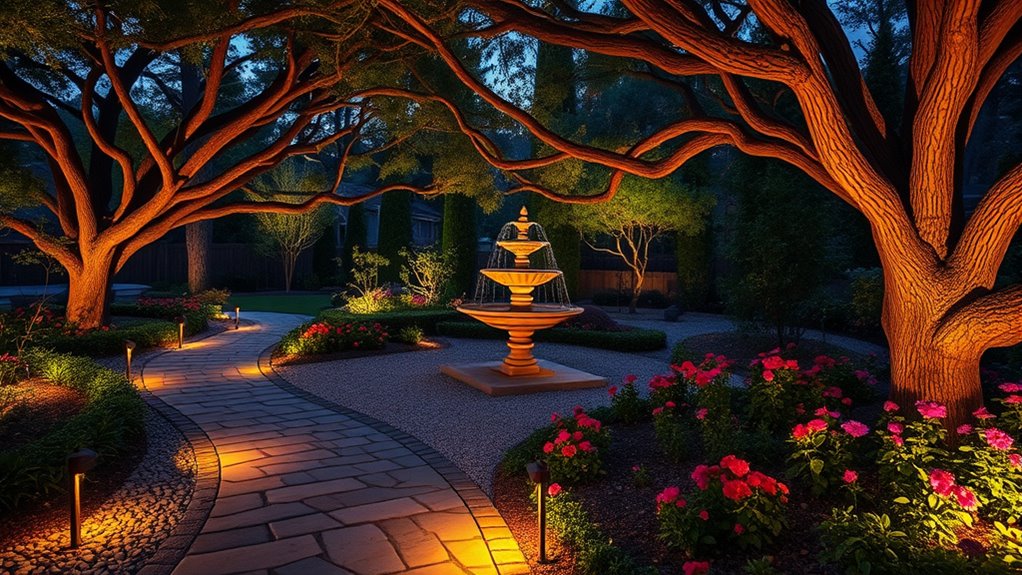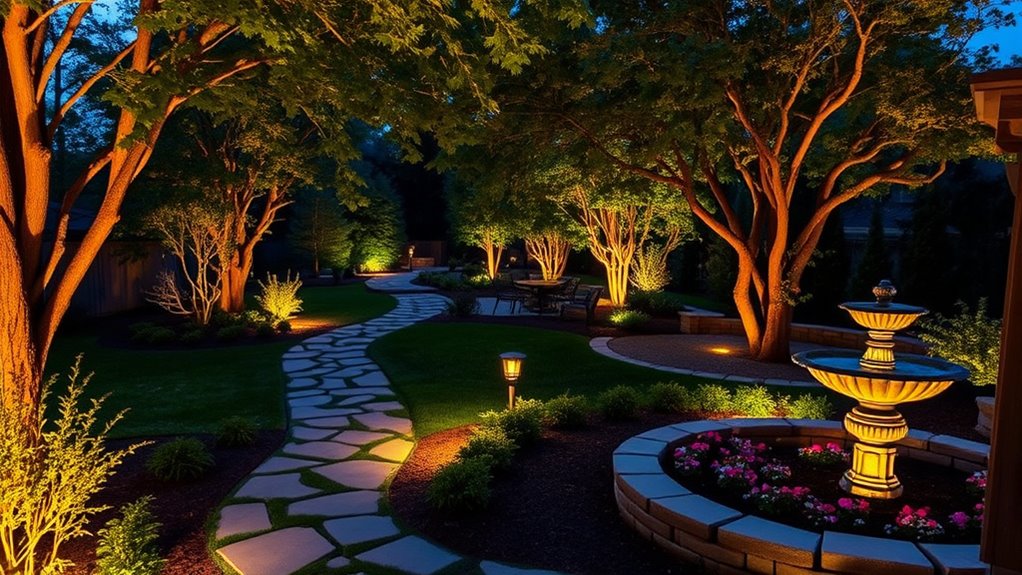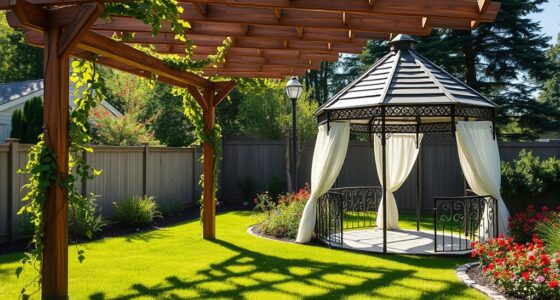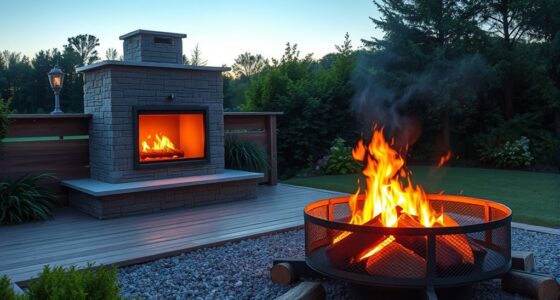To highlight your landscaping with outdoor lighting, focus on key features like pathways, trees, water features, and architectural details using accent and landscape lighting. Guarantee safety zones such as entrances, stairs, and driveways are well-lit to prevent accidents. Use a mix of fixtures—like uplights, downlights, and path lights—to add depth and visual interest, while security lighting enhances safety. By planning different zones with automation and layered lighting, you create a beautiful, functional space that shines after sunset. Keep exploring to uncover more tips.
Key Takeaways
- Use layered lighting to emphasize pathways, water features, and architectural elements for visual depth.
- Incorporate accent lights to highlight focal points like statues, trees, or fountains.
- Ensure safety zones such as entrances and stairs are well-lit to prevent accidents.
- Select fixtures with appropriate color temperatures and beam angles for functional and aesthetic balance.
- Implement zone control and automation for energy efficiency and tailored landscape illumination.

Creating an effective outdoor lighting layout begins with understanding your landscape’s key features and how you plan to use the space at night. You need to identify the main elements that require illumination, such as pathways, gardens, water features, and architectural details. By pinpointing these features, you can guarantee they’re properly highlighted to enhance both safety and visual appeal. Don’t forget to emphasize safety zones like entrances, stairs, and driveways. Proper lighting in these areas prevents accidents and provides peace of mind. Similarly, consider security lighting for dark or hidden spots that could be vulnerable to intruders. Brightening these areas helps deter unwanted visitors while improving overall security.
Identify key landscape features and safety zones to create a safe, visually appealing outdoor lighting plan.
Next, think about the aesthetic focal points you want to showcase, like statues, trees, or fountains. Properly lighting these features creates visual interest and adds depth to your landscape. You should also consider how your outdoor spaces are used at night. If you entertain often, you’ll want functional lighting that facilitates social gatherings, while relaxation zones might benefit from softer, mood-setting illumination. Prioritizing these needs helps you develop a lighting plan that balances safety, security, and beauty.
When selecting fixtures, think about how they align with your overall design vision. Choose lighting with the right color temperature—warm tones for cozy, inviting spaces, and cooler tones for sleek, modern looks. Be mindful of beam angles and brightness levels; you want enough light to highlight features without causing glare or light spill. Match fixture styles with your landscape or home architecture for a cohesive appearance, and opt for energy-efficient LED options to save on energy costs and reduce maintenance. Ensure fixtures are waterproof and weather-resistant to withstand outdoor conditions, prolonging their lifespan.
Layering your lighting creates depth and dimension. Combine ambient lighting for general illumination with accent lights to highlight specific features. Use task lighting along pathways and work areas for visibility and safety. Incorporate silhouette or shadow lighting to produce dramatic effects, especially on trees or architectural elements. Mixing different fixture types, like uplights, downlights, and path lights, adds visual interest and prevents your lighting from appearing flat or monotonous. Varying light intensities and angles further enhances the layered effect.
To keep control over your landscape lighting, create zones based on proximity or landscape features. Separate security zones from decorative or functional areas, allowing you to operate them independently. This setup enables you to turn on just the pathway lights during the night or switch off garden lighting when not needed, conserving energy. Proper wiring and control plans should account for zone separation and automation, aligning with your lifestyle needs, whether for entertaining, relaxing, or security.
Finally, incorporate lighting controls like timers, dimmers, and motion sensors. These devices help reduce power consumption, improve convenience, and extend the lifespan of your fixtures. Use photosensors to automate lighting based on ambient daylight, and occupancy sensors for security lights that activate on movement. Always consider local regulations and standards to ensure your outdoor lighting complies with safety and environmental guidelines. A well-planned outdoor lighting layout not only highlights your landscape’s beauty but also enhances safety, security, and energy efficiency.
You may also want to review the retail hours for any local hardware stores or specialty lighting shops to plan your purchases accordingly.
Frequently Asked Questions
What Are the Best Energy-Efficient Outdoor Lighting Options?
You’re asking about the best energy-efficient outdoor lighting options. LED lights top the list because they use up to 90% less energy, last longer, and are highly versatile. Solar-powered lights are also excellent, utilizing renewable energy to cut costs and environmental impact. Fluorescent and CFL lights are good for larger areas, offering efficiency and durability. Choosing the right option depends on your needs, budget, and desired ambiance.
How Do I Choose the Right Fixtures for My Landscape?
Choosing the right fixtures for your landscape is like selecting the perfect brush for a masterpiece. You’ll want to match fixtures to your features—spotlights for focal points, path lights for safety, and floodlights for broad coverage. Consider energy efficiency, durability, and how you want your space to feel. By balancing functionality with aesthetics, you’ll craft an inviting, well-lit environment that enhances your landscape’s beauty and safety.
What Is the Typical Cost of Professional Outdoor Lighting Installation?
You’re wondering about the typical cost of professional outdoor lighting installation. On average, it ranges from $2,100 to $6,000, depending on your project’s complexity and size. Basic setups with solar lights can start around $500, while high-end, custom designs may exceed $20,000. Most projects fall between $3,000 and $4,900. Factors like fixture types, coverage area, and additional features influence the final price.
How Can I Ensure Safety With Outdoor Lighting?
You’re probably thinking that brighter lights mean safer nights, right? Ironically, over-illumination can actually make things worse, increasing visibility for criminals or causing glare that hampers vision. To stay safe, aim for balanced lighting that directs downward, avoids glare, and keeps levels appropriate—around 1 to 15 lux. Use shielding fixtures and consider smart lighting solutions to enhance safety without creating unnecessary hazards or light pollution.
What Maintenance Is Required for Outdoor Lighting Systems?
To keep your outdoor lighting system in top shape, you need regular maintenance. You should inspect fixtures monthly for damage and loose fittings, check wiring for wear or corrosion, and replace any flickering or burnt-out bulbs promptly. Clean lenses every few months, remove debris, and trim vegetation to prevent obstruction. Schedule professional inspections periodically, and adjust sensor settings seasonally to ensure safety, efficiency, and long-lasting performance.
Conclusion
Think of your outdoor lighting as the delicate brushstrokes on a sunset painting. When you carefully plan and place each light, your landscape transforms into a vibrant masterpiece that beckons after dusk. With every flicker and glow, you’re guiding guests through your garden’s story, highlighting its beauty like stars lighting up the night sky. Embrace this artful process, and soon your outdoor space will shine with the brilliance of a well-crafted nightscape.








